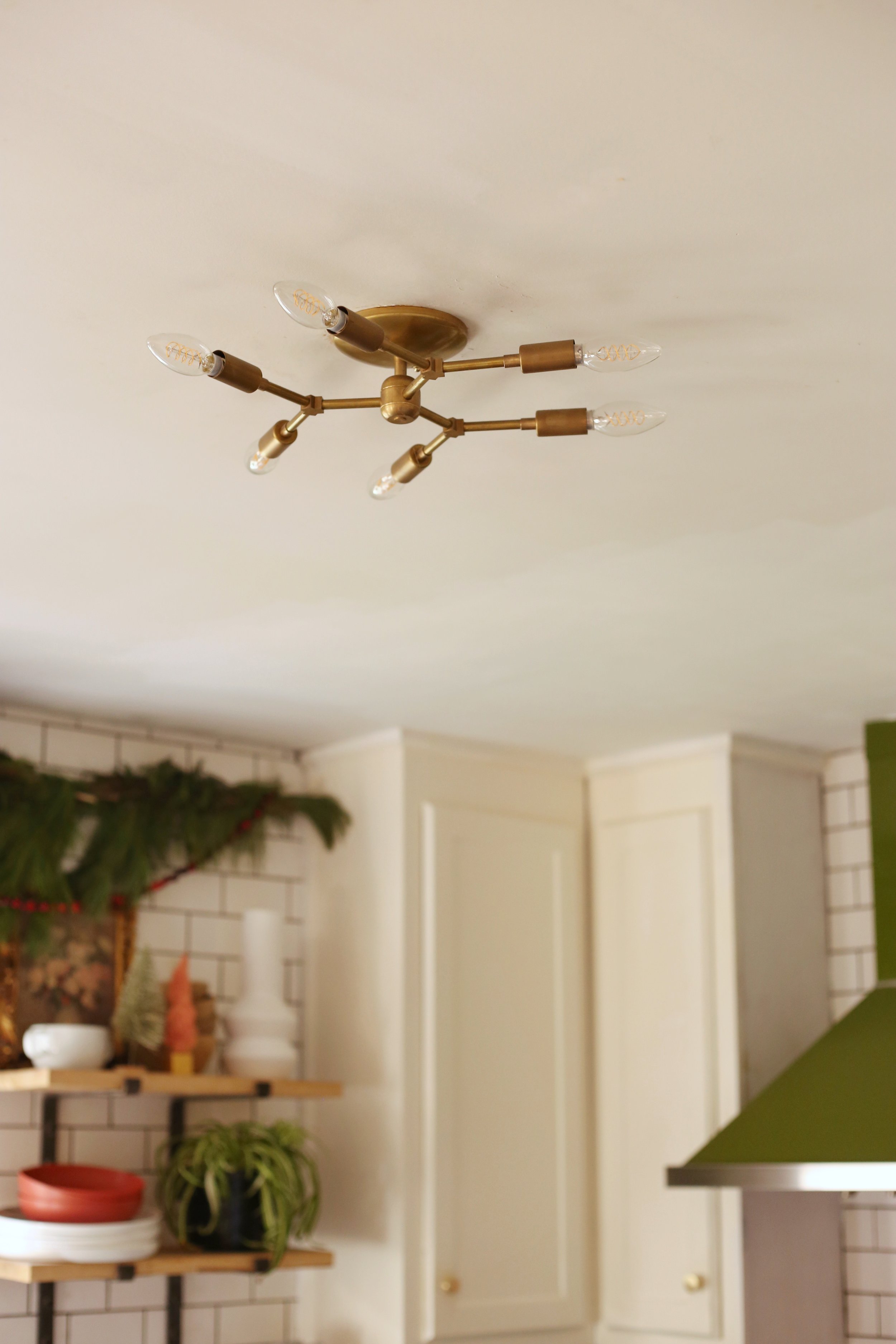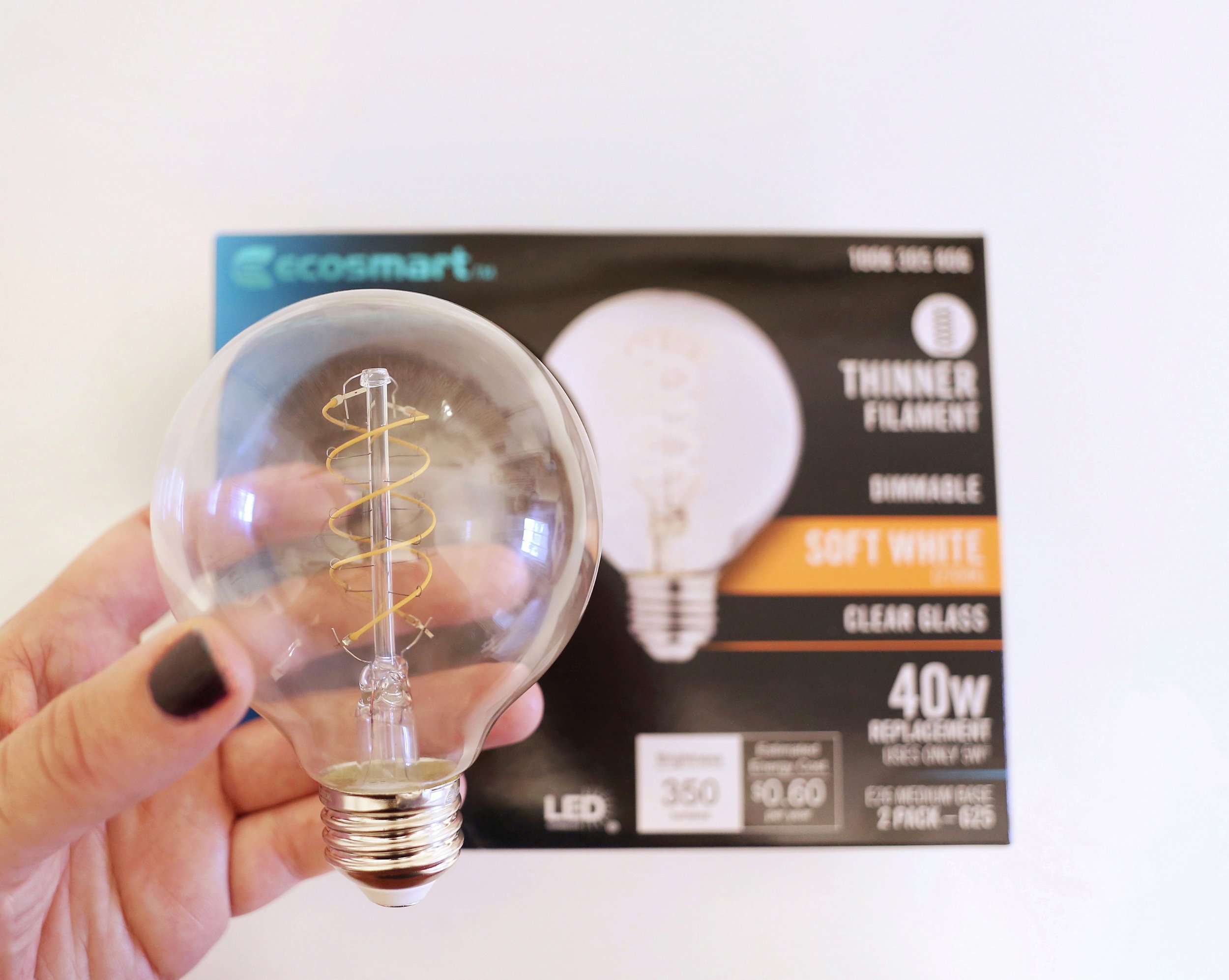Created in Partnership with EcoSmart and The Home Depot.
Choosing the perfect lighting is easy when you’re armed with a few tips!
I recently fell down a rabbit hole of the internet researching light bulb specs (It was a thrilling afternoon, I can assure you!)
After some time, I lifted my dizzied head full of all manner of information on wattage comparisons and Kelvin units and realized it might be helpful to create a light bulb guide for those who aren’t necessarily wanting to learn the detailed technology behind a bulb, but who simply want an easy guide on how to have nice looking lighting inside their homes.
With that in mind, I’ll be sharing with you the lighting options that I use in my own home, and hopefully, give you a simplified version of how to confidently choose the right light bulb for your situation without getting too
technical.
I use EcoSmart light bulbs throughout my entire house. EcoSmart has combined the latest in bulb technology with impeccable quality and affordability, which makes them my go-to when purchasing light bulbs. You can find EcoSmart bulbs exclusively at The Home Depot. But before you head off the store to load up on new lighting, I’ve got a few tips you’ll want to know first!
Check the wattage
I’m using EcoSmart’s Fine Bendy Filament LED Vintage Edison Light Bulb in my kitchen.
Before heading to the store, make sure you know the specific wattage of each of your light fixtures. The wattage specifics are easy to find, usually listed on a label attached near the bulb outlet.
The bulb wattage is the amount of energy a light bulb uses, and the wattage listed on your fixture is how many watts that fixture can safely handle.
In the past, wattage was the only spec you’d need to check, but for today's modern bulbs, you’ll also want to check the lumens on your light bulb as well. Lumens are the amount of light that a light bulb gives out, which then determines the brightness of the bulb.
If you’re ever matched the wattage of a bulb but forgot to check the lumens as I have in the past, you’ll end up with a bulb that shines brighter or dimmer than the other bulbs in your fixture. When this happens, you’ve most likely mismatched the lumens.
Check the bulb fitting
Always be sure to check the bulb fitting before purchasing a replacement bulb. These two EcoSmart Edison bulbs wouldn’t be compatible in the same light unit.
Light bulbs are made with different sizes and shaped fittings.
When replacing a bulb, you can usually find the size and shape listed on the base of the bulb in a letter-number combination. Make sure you know the fitting before you purchase so you don’t come home with a bulb base that is the wrong size for your unit.
Choosing your Light Temperature
Choosing the bulb temperature is where I’d usually get confused in the past. I’d feel overwhelmed standing in the light bulb aisle with rows of bulbs all describing a different color tone, and with each bulb manufacturer using a different description for color temperatures! In the past, I’d simply guess at which one would work well in my home, occasionally purchasing a very bad fitted temperature for my light fixture, casting an eerie, sterile light in the room.
To confidently choose the best fitting temperature for your bulb, you do need to have some knowledge of Kelvin temperature units.
Kelvin units are the color scale used to measure the color temperature of your light bulb ranging from a scale of 1,000 - to 10,000. The lower the number, the warmer the light, and the higher the number, the cooler the light source.
Here is a handy guide to break it down:
2700k Soft White
3000k Bright White
3500k True White
4000k Cool White
5000k Daylight I always go for 2700K for my home as a rule of thumb. This gives a warm and inviting atmosphere to my room that never feels sterile or harsh. I don’t look at the temperature description anymore when shopping for bulbs. Instead, I check the Kelvins listed on the packaging and match them to that.
Choosing Light Bulb Style:
The EcoSmart Dimmable Fine Bendy Filament LED Edison Bulb makes a statement in my bathroom vanity fixture.
Choosing a bulb style depends greatly on the type of fixture you’re using. For my interior light fixtures that feature an exposed bulb, I always use an LED filament, otherwise knowns as an Edison-style bulb. These bulbs give a decorative look and a true vintage feel. Filament bulbs come in different styles such as spiral or straight, so you can choose a style that fits your liking.
When choosing a filament bulb, I can’t emphasize enough the importance of choosing an LED bulb. As well as it being more energy-efficient, the lifespan of LED bulbs far surpasses the lifespan of a traditional bulb. The traditional filament bulb typically has 1,000 hours of bulb life, whereas an LED filament can have up to an impressive 40,000 hour bulb life! That’s a huge difference, and worth the switch to LED!
For lighting fixtures that conceal the look of the bulb such as a frosted globe pendant, I’ll choose a regular LED bulb instead of the filament style, which has an even longer bulb life than the filament LED and are typically are a bit more affordable as well!
Choosing Light Bulb Function:
During the Holidays, I used EcoSmart’s LED bulb with selectable color to add a splash of Holiday color to my living room.
Light bulbs have continued to evolve throughout history, and today's bulbs are pushing their functions even further.
There are many different types of bulbs to explore, such as smart bulbs which connect to Wifi and Bluetooth, interchangeable Kelvin bulbs that can switch from different color temperatures, dimmable bulbs, and color-changing bulbs. Needless to say, there is a world of convenience and creativity to explore!
EcoSmart offers a variety of uniquely functioning and colorful bulb options. I encourage you to browse their selection and become familiar with all a modern bulb these days can do!
The EcoSmart LED filament bulb in soft white is my go to all purpose bulb.
I hope you’ve found this guide to be a helpful rundown of everything you need to know when making an informed decision on choosing the right bulb for your home. It may seem like an overwhelming process at first, but once you understand the basics of the light bulb, it’s usually a pretty straightforward decision.
My go-to bulb in my home is the EcoSmart LED filament bulb with a wattage of 2700K.
You can find all of these bulbs I mentioned today from EcoSmart at The Home Depot conveniently located online and in stores.






